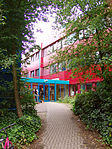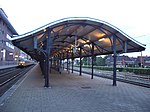Drakensteyn Castle
1640 establishments in the Dutch RepublicBaarnBaroque palaces in the NetherlandsCastles in Utrecht (province)Houses completed in 1640 ... and 3 more
Palaces in the NetherlandsRijksmonuments in Utrecht (province)Royal residences in the Netherlands

Drakensteyn Castle (Dutch: Drakensteyn, sometimes Drakesteijn or Drakestein) is a small castle at 8 Slotlaan in the hamlet of Lage Vuursche, in the municipality of Baarn, Netherlands. It is the private residence of Princess Beatrix of the Netherlands, the country's former Queen. The royal connection aside, its most distinctive feature is its octagonal shape. It is surrounded by a moat that can be crossed via a bridge. Its style can be described as Classicist.
Excerpt from the Wikipedia article Drakensteyn Castle (License: CC BY-SA 3.0, Authors, Images).Drakensteyn Castle
Zevenlindenweg,
Geographical coordinates (GPS) Address Nearby Places Show on map
Geographical coordinates (GPS)
| Latitude | Longitude |
|---|---|
| N 52.179722222222 ° | E 5.2272222222222 ° |
Address
Drakensteyn
Zevenlindenweg
3749 AS
Utrecht, Netherlands
Open on Google Maps









